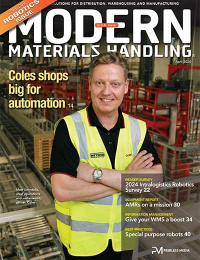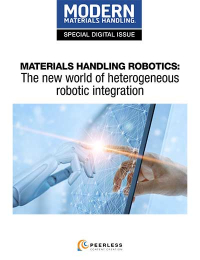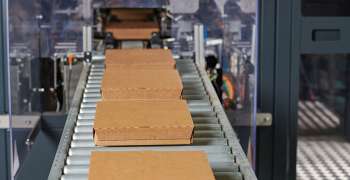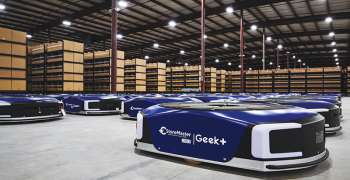Shipping Pallets: The complete package
Latest Material Handling News
Two voices of reason on pallet materials 60 Seconds with Bob Trebilcock, outgoing executive editor, Modern Materials Handling Learn from lift truck service history The reBound Podcast: How Pitney-Bowes is innovating with autonomous vehicles. Packaging Corner: Be open to change More Blogs“We are material neutral,” declares Laszlo Horvath. “I think that’s important for people to know.”
As the new director of the Center For Unit Load Design at Virginia Tech University, Horvath is taking the helm of a research lab with a heritage of putting wooden pallets to the test. Today, he says, the center, its students and faculty are still involved in research related to pallet design. But wooden pallets are now just one component of the unit load, which may also include alternative pallets such as plastic and metal along with corrugated containers, stretch film and strapping. With its emphasis on the unit load, the center is evaluating them all. “We do not push wood over plastic or any other material,” Horvath says. “We are looking for the best pallet and the best materials for the application.”
More importantly, as the name of the center implies, Horvath, his colleagues and their students are looking beyond the pallet to research and test how all of the components of the unit load work together to get product from the end of the manufacturing line to the ultimate customer. In other words, they’re looking at the complete package.
“Over the last few years, packaging designers have brought us their products so we can put them to the test and give them ideas on how to improve what they’re doing,” Horvath says. “And shippers are coming to us with unit loads, especially when they have issues with stability during distribution. As a research center, we think it’s important to do more than just test a product or a load. If it’s falling apart, we want to understand what’s going on inside the package or the load and give them ideas on how to improve the design.”
The exercise is valuable to the companies that rely on the lab. Getting to the root of the problem also provides practical experience for Virginia Tech students who will soon graduate and enter industry, Horvath adds.
Going forward, one of Horvath’s goals is to ramp up the number of research projects related to unit load design. Here are a few of the ideas he wants the center to pursue:
A mathematical formula to calculate the containment force of stretch wrap on a load. “Currently, if you’re trying to stabilize a load with stretch wrap, you have to do a lot of trial and error on different patterns until you get the containment force and wrap design that works,” Horvath says. “We’re developing a mathematical formula that will allow people to calculate the containment force in advance. That will reduce the number of times you have to test the load to get it right.”
Stress distribution on a pallet: “Purchasing people often take wood out of the pallet to save money,” says Horvath. “What they don’t realize is that there is a new stress distribution on the pallet that may affect some of the products in a package more than others.” That’s one of the reasons some bottles or cans may leak even if the load is in tact. Horvath wants to develop a model that can simulate the stress distribution on a unit load to create better packaging and unit load designs.
Mold prevention: Pallets made the news last year when Johnson & Johnson blamed moldy pallets produced in the Caribbean for the contamination of product manufactured and packaged in Puerto Rico. The center is investigating ways to prevent the growth of food pathogens and mold on pallets using a wood byproduct that is already used in the production of food. “The material we’re working with is eco-friendly and approved by the FDA as a food product,” says Horvath. “If you can put it in food, you can put it on a pallet.”
Life-cycle analysis: Wood or plastic may not rank up there with the plastic or paper question at the grocery store, but it’s a question that pallet users often ask. Right now, there’s no way to answer that question based on real world experience. “We want to do a life cycle analysis of the pallet once it’s out there in the distribution world and create a tool that will help companies decide which is better for their application,” Horvath says.
The projects are ambitious. But, the biggest selling job Horvath may have is convincing companies that paying closer attention to the complete package can save them money. “Most companies do not come to us when they are designing their pallets and packaging,” Horvath says. “They come to us when things are falling apart. Usually, that’s because they don’t have packaging people on staff who understand pallets, corrugated and stretch wrap. We want to convince them that the kind of systems-based approach to packaging that we’re teaching our students can save them money. After all, that’s what they want: to save money.”

Article Topics
Blogs News & Resources
Two voices of reason on pallet materials 60 Seconds with Bob Trebilcock, outgoing executive editor, Modern Materials Handling Learn from lift truck service history The reBound Podcast: How Pitney-Bowes is innovating with autonomous vehicles. Packaging Corner: Be open to change 60 Seconds with Robert Martichenko of American Logistics Aid Network The reBound Podcast: Looking for talent in all the right places: How Essendant is revolutionizing recruitment More BlogsLatest in Materials Handling
Beckhoff USA opens new office in Austin, Texas Manhattan Associates selects TeamViewer as partner for warehouse vision picking ASME Foundation wins grant for technical workforce development The (Not So) Secret Weapons: How Key Cabinets and Asset Management Lockers Are Changing Supply Chain Operations MODEX C-Suite Interview with Harold Vanasse: The perfect blend of automation and sustainability Consultant and industry leader John M. Hill passes on at age 86 Registration open for Pack Expo International 2024 More Materials HandlingAbout the Author
Subscribe to Materials Handling Magazine

Find out what the world's most innovative companies are doing to improve productivity in their plants and distribution centers.
Start your FREE subscription today.
April 2024 Modern Materials Handling

Latest Resources










